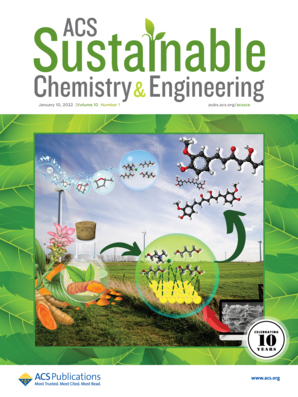双网气凝胶微球固定NH2-MIL-125萃取放射性废水中的铀
IF 7.1
1区 化学
Q1 CHEMISTRY, MULTIDISCIPLINARY
引用次数: 0
摘要
从废水中回收核能源U(VI)的环境友好型吸附剂对资源回收和环境保护具有重要作用。本研究以海藻酸钠、聚丙烯酸和NH2-MIL-125 (NM@SA)为原料,采用温和法制备了双网状气凝胶吸附剂复合材料,用于模拟废水样品中U(VI)的去除和浓缩。吸附动力学和等温线模型表明,在NM@SA上吸附U(VI)为单层化学吸附过程。根据Langmuir模型计算,NM@SA对U(VI)的最大吸附量为703.6 mg·g-1。此外,该吸附剂在大规模操作中保持了良好的吸附能力、可回收性和可重复使用性。同样的能力也可以在真实的海水环境中得到证明。最后结合实验测定和表征结果,讨论了U(VI)在NM@SA上的潜在吸附机理。总的来说,本研究为处理含U(VI)放射性废水提供了一条有利的研究途径。本文章由计算机程序翻译,如有差异,请以英文原文为准。

Uranium Extraction from Radioactive Wastewater by NH2-MIL-125 Immobilized in a Double-Network Aerogel Microsphere
An environmentally friendly adsorbent for recovering nuclear energy source U(VI) from wastewater plays a crucial role in resource recovery and environmental preservation. In this work, a double-network aerogel adsorbent composite constructed from sodium alginate, poly(acrylic acid), and NH2-MIL-125 (NM@SA) was fabricated by a mild method, which was adopted to remove and concentrate U(VI) in the corresponding simulated wastewater samples. According to the results of adsorption kinetic and isotherm models, the adsorption of U(VI) on NM@SA was a monolayer chemisorption process. The maximum adsorption capacity of NM@SA for U(VI) calculated from the Langmuir model was 703.6 mg·g–1. In addition, the adsorbent maintained excellent adsorption capacity, recoverability, and reuse in large-scale operation. The same abilities can be demonstrated in real seawater environments. Finally, the potential adsorption mechanisms of U(VI) on NM@SA were discussed in conjunction with the experimental determination and characterization results. Overall, this study introduces an advantageous research approach for treating U(VI)-containing radioactive wastewater.
求助全文
通过发布文献求助,成功后即可免费获取论文全文。
去求助
来源期刊

ACS Sustainable Chemistry & Engineering
CHEMISTRY, MULTIDISCIPLINARY-ENGINEERING, CHEMICAL
CiteScore
13.80
自引率
4.80%
发文量
1470
审稿时长
1.7 months
期刊介绍:
ACS Sustainable Chemistry & Engineering is a prestigious weekly peer-reviewed scientific journal published by the American Chemical Society. Dedicated to advancing the principles of green chemistry and green engineering, it covers a wide array of research topics including green chemistry, green engineering, biomass, alternative energy, and life cycle assessment.
The journal welcomes submissions in various formats, including Letters, Articles, Features, and Perspectives (Reviews), that address the challenges of sustainability in the chemical enterprise and contribute to the advancement of sustainable practices. Join us in shaping the future of sustainable chemistry and engineering.
 求助内容:
求助内容: 应助结果提醒方式:
应助结果提醒方式:


